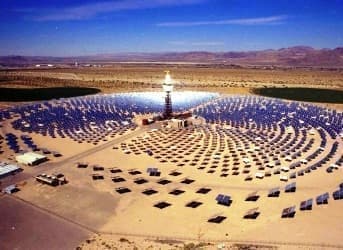Arguably, the Middle East and North Africa are ripe for renewable energy investment, particularly in the solar energy sector and specifically in terms of concentrated solar power (CSP). Because it relies on its own oil, it can afford the massive subsidies necessary to weather the transformation that could eventually make renewable energy affordable and accessible. Those subsidies become more affordable when Middle Eastern governments take stock of the savings on rising domestic oil and gas consumption that can be diverted to more revenue-generating exports.
A number of recent developments highlight the push for renewable energy in the MENA region, from Saudi Arabia’s ambitious solar plans to Qatar’s first-ever polysilicon plant and massive concentrated solar power plants across North Africa.
In May, the Saudi government peaked interest in its solar energy scene by announcing that the kingdom planned to install 41 GW of solar systems by 2032, and to build up wind, geothermal, and nuclear energy sources.
Banks in Qatar have given new impetus to the country’s solar energy ambitions, financing the construction of the first solar-grade polysilicon production plant to the tune of $1.1 billion. The plant is a joint venture between the Qatar Foundation that brings together Qatar Electricity and Water (QEWC) and Qatar Solar Technologies (QSTec). The plant, located in the Ras Laffan Industrial City, will have an 8,000 metric ton capacity and the first phase of construction is expected to be completed in mid-2013. Ultimately, this will be the foundation of the country’s solar industry as the plant will provide materials for the manufacture of solar panels.
In Iran, the government has announced plans for a 5MW pilot geothermal energy project and is setting its sights on an increase of 12,000 megawatts of renewable energy. Bahrain is also stepping onto the solar scene. On 31 May, Bahrain announced plans to construct a solar smart grid in Awali, which will have a 5MW solar capacity operated by a wireless smart grid network. Similar efforts are being considered in Jordan.
One of the first major Middle East renewable energy projects originated in the United Arab Emirates, in the form of the construction of a massive city, Masdar City, in the desert that focuses on renewable energy, including electric public transportation.
In North Africa, Morocco has led the renewable energy race, first in 2009 with a $9 billion investment in a national solar plan that aims to eventually provide nearly 40% of the country’s energy needs, and second through an ambitious concentrated solar power (CSP) project.
CSP, as opposed to solar panel installation (photovoltaics), is undertaken at massive plants where sunlight is converted into heat, which in turn drives a steam turbine that generates electricity. It is this sector that has vast potential in the Middle East and North Africa, and there are some ambitious projects in the works.
One of those projects is a series of massive solar power farms spanning the Middle East and North Africa. Two projects under this Desertec umbrella are Morocco’s Ouarzazate Concentrated Solar Power plant, which was approved in late 2011, and Tunisia’s TuNur Concentrated Solar Power Plant, which was approved in January 2012. The Moroccan plant will have a 500-MW capacity, while the Tunisia plant will have a 2 GW capacity. TuNur would be the largest ever thermal power plant and would be capable of producing twice as much energy as the average nuclear power plant.
Desertec’s CSP plants would supply energy to the MENA region and export excess energy to Europe. At the same time, given the mounting water crisis in the region, the desalinated water produced during the solar energy process could be distributed to areas in need, particularly Egypt.
For the oil-rich countries of the region, developing renewable energy platforms is easy enough even heavy subsidies, for the rest of the region, particularly North Africa, this is not so easy and investors are hesitant to take the security risk.
Morocco’s CSP station requires a total of around $1.25 billion to bring it across the finish line, and while the African Development Bank Group has chipped in $336 million in funding, the remainder is still an uncertainty.
One development that may boost funding for MENA renewable energy projects is the situation in Europe, where some government have already cut renewable energy subsidies, particularly in the solar sector, and others are considering cuts. Solar investors in Spain, German, Italy and the United Kingdom are increasingly open to seeking opportunities outside Europe in order to survive in a potentially zero-subsidy environment. On this level, the Middle East is highly attractive. North Africa is less so, due to regulatory ambiguities and stability concerns, but the potential is vast for anyone willing to take the risk.
By. Charles Kennedy


















